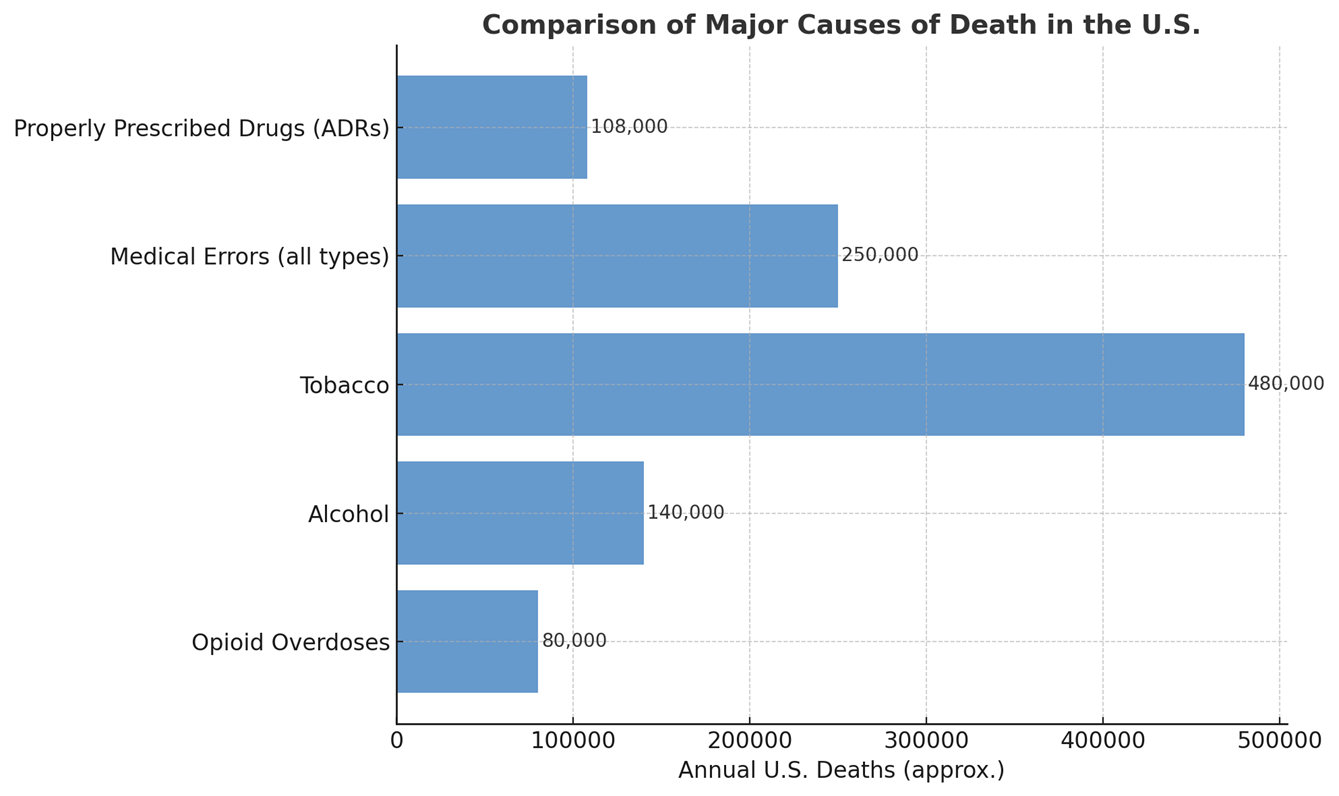Knowing the appropriate dosages is important for both practitioners and patients, as dosages are mission-critical for achieving therapeutic effects without overdosing and creating serious side effects. In pharmaceutical medicine, the critical dose of a medicine refers to the minimum amount necessary for a therapeutic effect.
That is an important dosage because what comes with increasing dosages of pharmaceuticals is increasing side effects and even death from prescribed or even over-the-counter medicines. It was estimated that approximately 108,000 people in America alone die from properly prescribed pharmaceutical medicines. CDC (2020s): Adverse drug events send 1.3 million people to emergency departments each year in the U.S. and cause 350,000 hospitalizations among older adults annually. While not all are fatal, the burden is high.
In the U.S., acetaminophen overdose alone is one of the leading causes of emergency room visits and acute liver failure and death. Estimates range from 70,000 to 80,000 ER visits per year, with thousands of hospitalizations. “The danger is that there isn’t much difference between a safe, effective dose and a toxic dose. Just a doubling of the maximum daily dose can be enough to kill, warns Dr. Anne Larson of the University of Washington Medical Center. The other problem is that if you have no food in your stomach, or if you have alcohol in your system, or worse yet, both (not relevant for your kids unless they’re teenagers, but think about that Tylenol you took for your hangover last month), the regular dosage can be toxic because of the overload to the liver.”

Tylenol (acetaminophen) metabolism depletes glutathione (GSH), the liver’s primary antioxidant and detox molecule. GSH depletion increases oxidative stress and reduces the body’s capacity to neutralize mercury. Mercury exposure (from environmental or medical sources) requires GSH conjugation for detoxification. When GSH levels are low, mercury accumulates in tissues, including the brain, thereby intensifying oxidative stress and impairing neurodevelopment.
This convergence of Tylenol-induced GSH depletion and impaired mercury detox may increase vulnerability to conditions such as autism spectrum disorders. Thus, the use of Tylenol (especially repeated in infants/children) could lower the body’s ability to excrete mercury, thereby heightening oxidative stress. So, JFK Jr. is not out of his mind making a connection between Tylenol and autism.
The Dose Makes the Poison
The dose makes the poison is a well-worn concept. The word poison was first recorded in Middle English in a work composed around 1200. A poison is any substance that, when introduced into or absorbed by a living organism, destroys life or injures health. A poison is a material that inhibits other substances, especially enzymes, and the vital biochemical processes they are involved in. Enzymes are crucial because every chemical change that takes place to repair tissue or to assimilate food involves the activity of enzymes. Without enzyme activity, there is no biological activity, no life. The word poison correctly describes pharmaceuticals, though the industry tries to hide this fact.
The effects of poisons can be quick or extremely slow, building gradually up, creating low-grade debilitation diseases like chronic fatigue syndrome or devastating neurological disorders like MS, ALS, and Alzheimer’s disease. Nothing will burn up a neuron faster than heavy metal mercury, which was, until very recently, injected into babies starting at six months of age, until Kennedy banned it from all fifty states. It was in Hep B birth shots until the turn of the century.
Vancouver neuroscientist Dr. Chris Shaw shows a link between the aluminum hydroxide used in almost all vaccines and symptoms associated with Parkinson’s, amyotrophic lateral sclerosis (ALS, or Lou Gehrig’s disease), and Alzheimer’s. It is probably connected to autism, which, without doubt, has multiple causes.
Wrong Dosages Wrong Medical Concepts
It is mistakenly thought that if the dose is low enough, even a highly toxic substance will cease to cause a harmful effect. The toxic potency of a chemical is ultimately defined by the dose of the chemical that produces a specific response in a particular biological system. “In all of these debates, the key point that is not often understood is that it’s the dose that makes the poison,” says Dr. Carl Winter, an expert in toxicology at the University of California, Davis. “The tendency is to exaggerate toxicity. It’s a slippery slope to draw the line on what represents a legitimate concern and what restrictions should apply.” This is, of course, not true for something as strong as plutonium. The crucial issue with plutonium is not volume or mass—it’s toxicity.
The Romans were aware that lead could cause serious health problems, even madness and death. However, they were so fond of its diverse uses that they minimized the hazards it posed. What they did not realize was that their everyday low-level exposure to the metal rendered them vulnerable to chronic lead poisoning, even while it spared them the full horrors of acute lead poisoning. Roman engineers ultimately brought down the Roman Empire when they replaced their stone aqueducts with lead pipes for the transport and supply of drinking water, thus turning much of the Roman population into neurological cripples.
“The prolonged effects of low-grade concentrations of toxic substances depend on individual susceptibility,” says Professor I. M. Trakhtenberg from the former Soviet Union. The science of low-level toxicity reveals that it matters what is happening at the parts-per-million, parts-per-billion, and even parts-per-trillion levels. As our instruments have become infinitely more sensitive, scientists have been able to penetrate into new worlds of chemical sensitivity that Paracelsus could not have possibly imagined.
Hormesis
“What doesn’t kill you makes you stronger” is a phrase that many feel contains more than a grain of truth. It describes the theory of hormesis — the process whereby organisms exposed to low levels of stress or toxins become more resistant to more severe challenges. It is thought that a low dose of a poison can trigger certain repair mechanisms in the body, and these mechanisms, having been initiated, are efficient enough that they not only neutralize the toxin’s effect but can even repair other defects not caused by the toxin. Nice theory to justify poisoning people and taking pot luck at achieving the right dose. It makes much more sense to dance with magnesium and other extraordinarily safe substances that don’t poison the patient.
Calculating Dosages for Natural Medicine
Measuring critical dosages, when using natural medicines, refers to the maximum amount that can be taken to achieve the desired therapeutic effect. In my Natural Allopathic Medicine, we often take doses at exceedingly high levels without the side effects found in pharmaceuticals, which are an ever-present danger even at very low doses. In natural medicine, the dose determines the effect, and we want and need strong doses to effect cures. The adverse effects of natural medicines are extremely rare. Almost zero!
Magnesium, hydrogen, and everything else in my Natural Allopathic protocol are lifesaving. The secret to safe and effective medicine lies in using medicinal substances that do not have side effects in reasonable and even high doses, meaning they are not toxic. This is the very meaning of safe, something that will not harm or hurt you. The key to any natural protocol is getting the doses high enough; however, with most substances, it is best to start out low and get used to each substance and then slowly bring the doses up. Believe it or not, a century ago, if one got syphilis, doctors would prescribe a gram of iodine.
If one’s motive is to treat and heal people of their disorders, the first thing to think of and do is to give the body what it needs. It is fundamental medical reasoning. Learning to use a natural medicine (even though it might be used in an emergency room) is not the same as using and prescribing a pharmaceutical, which needs formal training in how to poison “safely.” Pharmaceuticals are mitochondria poisons with side effects that are actually the main effects if the truth be told. Natural medicine and nutritional laws run by one set of rules, while pharmaceutical companies operate under another.
Conclusion

Auroleus Phillipus Theostratus Bombastus von Hohenheim, immortalized as “Paracelsus” and sometimes called “the father of toxicology,” was born in 1493. Paracelsus, a Swiss doctor, pioneered the use of chemicals and minerals in medicine. Paracelsus was the first to say, “It depends only upon the dose whether a poison is a poison or not. A lot kills; a little cures.” So, he would take a very toxic substance like mercury and use it to cure epilepsy, something no one in their right mind would do now.
The assumption that poisons can be used safely is modern man’s Pandora’s Box; once opened, the greediest, power-hungry industrialists felt free to use poison in everything from household products like soap and shampoo to putting it directly in our food, medicines, and even our drinking water.
The best natural medicines are the ones you must have—no matter what—to continue your life. Nutritional law is vital to resolving disease, not pharmaceuticals that damage cellular environments. Our cells need the right conditions for health and recovery from disease. There is no substitute for a nutrient that is lacking in the body. No pharmaceutical can replace a nutritional deficiency.
Today, we need more nutrients, not less, because toxicities of too many types are a plague affecting the entire biosphere. We consume extra nutrients in the process of detoxification. However, over the last fifty years, the nutritional value of foods has been declining, so we get less, we become sick, and we die. Superfoods help us make up the slack by addressing profound dietary deficiencies. It is also one of the basic reasons why minerals make such excellent medicines. Magnesium, bicarbonates, iodine, selenium, sulfur, and even lithium can be transformed into potent medicines when used in appropriate high dosages.
Dr.Sircus is a reader-supported publication. To receive new posts and support my work, consider becoming a free or paid subscriber.
Subscribe now




comments